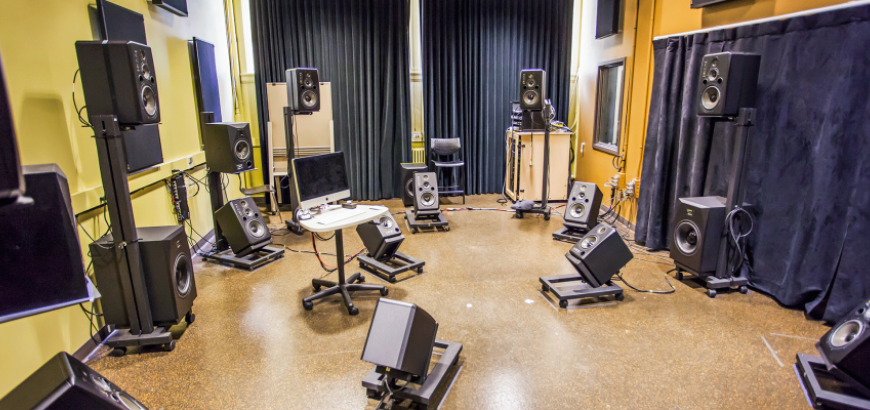Jump to:
WEB INTERFACE TROUBLESHOOTING [opens new wiki page]
- Overview
- Audio Connection (How to connect a computer to the system)
- Routing and Decoder Settings (via web interface)
- Web interface won't load? troubleshooting instructions are HERE.
- Sample rate
- Input Ambisonic Format
- Ambisonic decoder
- Discrete channel routing (no decoder)
- Patching directly to speakers via the patch bay
- Auxiliary routing to your own speakers/devices
- Current System Settings, Gain, Stereo, Listening Diameter, Rotate
- Changing the Sample Rate, Decoder, Channel Routing, Room Correction
- Room Correction
- Live Input / Recording
- Troubleshooting
- Detailed Routing and Boot Instructions [opens another wiki page]
- Reservation Calendar
Overview
Room 117 uses 24 full-range speakers and 4 subwoofers for full height spatial sound reproduction. There is a routing decoding system to care of patching, ambisonic decoding, speaker balancing and room correction, and the crossovers for distributing sound to the subs. You can send a B-format signal to various decoders or address each speaker individually, depending on settings.
Audio Connection
- On either the Sound Lab iMac or your own laptop, connect to the RME MADIface USB via USB.
- Is your computer not seeing the device? You need to download the driver for it HERE. This requires a reboot after installing.
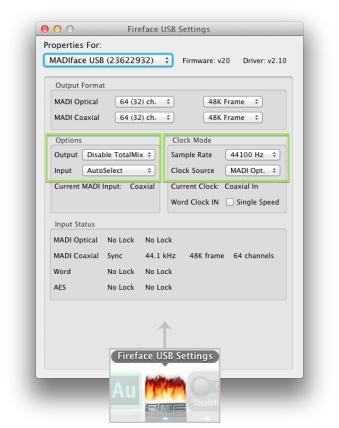
- In the Fireface USB Settings applet, make sure:
- Options > Output > "Disable TotalMix"
- Clock Mode > Clock Source > "MADI Opt." (Note this is "BNC In" for Room 205)
- Confirm your Sample Rate.
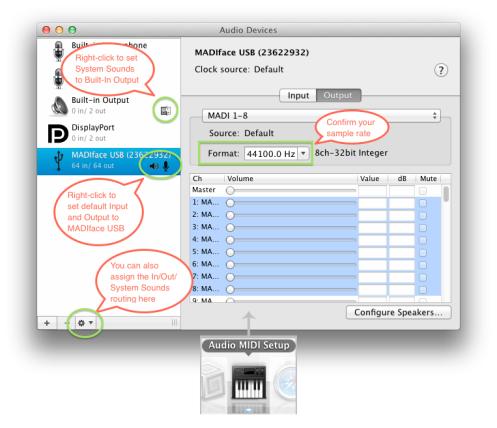
- In Audio MIDI Setup (Applications>Utilities), confirm that the MADIface’s Sample Rate matches that of the hardware in the rack.
- To change the sample rate, use the web interface, then confirm that the sample rate automatically updates on the RME MADIface. See decoding/router instructions below for details.
- Make sure your system defaults to the MADIface USB so Applications use it and SC will boot with that as its interface. Right Click MADIface USB to change this setting.
- NOTE: you may want to set your “system sounds” to still play back to your Built-In Output.
- All sound goes through the Volume Knob, which is an active attenuator.
Audio sent from your machine will be routed/decoded in the room based on the router and decoder settings, detailed below.
Routing and Decoder Settings
From a web browser, go to dx117decoder.local:8080 (this is in the Chrome bookmark bar).
Current System Settings, Gain, Stereo, Listening Diameter, Rotate
Current System Settings are displayed on the left side of the page. Controls on the left side of the page can be updated in real-time (i.e. no need to select Apply to update the settings). These include:
- Gain (volume), Mute, Attenuate (reduce volume by 25dB) in realtime. Note: This is digital amplitude control, so an amplitude above 0dB may cause clipping in the hardware output stage.
- Listening Area Diameter can be set to accomodate a larger audience by increasing the diameter to the footprint of the group you have (within limits). Specifically, this sets the ambisonic decoder's crossover between "velocity" and "energy" decode.
- Stereo. When enabled, the first 2 channels of sound sent to the routing system will be automatically routed to the front left and right speakers. Any following channels will be sent to the decoding/routing system, i.e. the decoder input is offset by 2 channels on the input. When disabled, all audio channels are sent along to the decoder/router with no input channel offset.
- Rotate will rotate your soundfield decode so that the front is 90 degrees to the right.
Changing the Sample Rate, Decoder, Channel Routing, Room Correction
To change these settings, you must select the settings you want on the right half of the page and click Apply. You’ll see a readout of what’s happening in the Post window. Once updated the new settings will display in the yellow frame labeled Current System Settings.
Sample rate
The sample rate can be selected from the dropdown menu. Click "Apply" to change the sample rate. This will restart the routing system so the controls will go offline temporarily while the change takes effect. You can track the progress in the "Post" window. Once updated, you'll see the sample rate updated in the "Current System Settings" window.
IMPORTANT: Confirm that the sample rate has been updated in the Fireface USB Settings, changing it manually if necessary. Sometimes the Fireface USB is running at half of the appropriate sample rate, creating a doubling of channels. If you experience any problems, check that the sample rate matches between all the devices: the Web interface, Audio MIDI Setup, Fireface USB Settings applet, and the Big Ben in the gear rack (top unit).
Input Ambisonic Format
Here you can select what ambisonic input you are sending to the decoder. You can choose from "FuMa" (Furse-Malham), "AmbiX" (ACN SN3D), or "AtkHoa" (ACN N3D). Note: on all of the room Mac Mini's there are now test signals with the various formats so you can test your input format/decoder combination.
Ambisonic decoder
Depending on the room you’re in, various ambisonic decoders are available in horizontal (2D), dome, or spherical (3D) layouts. The names should give you some indication of the speaker layout of each decoder. Examples follow. Note: you can rotate your soundfield by 90 degrees to the right, effectively doubling the number of decoder orientations available simply by rotating your soundfield withing a decoding layout.
- Full_2D: 6-channel horizontal decoder, the oriented such that front is on the face of the hexagon.
- Full_3D: A full-sphere decoder using all 24 of the speakers.
Remember: If “Stereo First” is enabled, decoder input channels are offset by 2 channels.
Discrete channel routing (no decoder)
You can route your audio directly to speakers, starting with the floor left speaker (in the ring of three) proceeding clockwise, then jumping to the lower front left speaker of the floor-elevation ring, proceeding clockwise, then the speaker directly center in the mid-height ring, proceeding clockwise, then upper front left of the ceiling ring of six, proceeding clockwise, then the upper center speaker in the top ring of three, followed by the subs, front center, clockwise. There are different channel group presets which may offer convenient routing to specific layouts, such as hex and quad layouts. The channel layouts are as follows:
- All: all channels in order (they are labeled, starting at 0)
- Quad: [front-left, front-right, back-left, back-right]
- Hex_Vertex: [front-center, front-left, front-right, back-left, back-right, back-center]
- Hex_Flat: [front-left, front-right, mid-left, mid-right, back-left, back-right]
- Oct_Vertex: [front-center, front-left, front-right, mid-left, mid-right, back-left, back-right, back-center]
- Oct_Flat: [front-left, front-right, front-mid-left, front-mid-right, back-mid-left, back-mid-right, back-left, back-right]
Note: If “Stereo First” is enabled, direct speaker routing is offset by 2 channels.
Direct patching to speakers via the patch bay
Use the bottom row of the patch bay to connect directly to speakers. Channel order follows the Discrete routing order. Stereo Left and Right patch points are labeled.
Auxiliary routing to your own speakers/devices from system hardware
For the first 24 outputs from the system, you can connect a 1/4" TRS plug in the top row of the patch bay to intercept the audio being sent to that channel, pre-Gain knob, line level. Remember these are the direct speaker feeds, so any decoder/correction (filtering) settings are applied to the signal before being sent out– so you'll likely want to simply use Discrete routing and no room correction. Note that currently, the first 21 channels (speaker feeds) will always have some delay/gain compensation, even without using room correction, as part of the system's speaker balancing. This is very little from difference from channel to channel, but if this is undesireable, consider using channels above 21, which will roll over into the patchbay on top of the gear rack.
Room Correction
Room correction aligns all the speakers in time, matches loudness across the array, and adjusts the spectral coloration of each speaker to allow for more transparent listening into the soundfield. Note: As you make your setting selections, text below the setting controls will tell you whether or not your current selection has a filter match. You must select options until a match is found.
Selecting Balanced removes any corrective filtering and applies only amplitude and delay compensation to "balance and align" the speakers. Balanced should be considered a complete selection with no other correction options (i.e. The balanced button de-selects any filtering selections and vice versa).
The options in the dropdowns and check boxes apply equalizing filters which attempt to counteract coloration from the room acoustics. You must select at least an "amount" and a "phase" option (dropdown menus).
The "amount" setting refers to the amount (or agressiveness) of filtering applied. There are 3 options:
- OPEN - The most "passive" setting, which allows for more flexibility as to how close the listener needs to be to the sweet spot. The spectral correction (EQ curve) may be regarded as "least active" and “smoothest” as compared to the following settings. This is considered a default for general listening, especially with more than one person.
- MODERATE - This setting provides more "active" correction, with more spectral resolution in correcting the coloration of each speaker, also allowing more latitude in gain correction in each frequency band. This is for a more critical listening scenario where the listener is expected to be consistently in the middle of the array. While the soundfield “opens up” to provide more clarity in the sweet spot, there is more coloration of the sound for off-center listeners.
- TIGHT - The most "active" correction for a listener "tightly located" in the center of the array for critical listening. One will observe potentially undesirable tonal coloration (and therefore spatial artifacts as well) outside of the sweet spot. From the proper sweet-spot listening location this setting can provide the most clarity in terms of spatial imagery and tonal coloration.
There are 2 phase options:
- Reference refers to the correction type which applies phase correction as well as magnitude correction, which is generally preferred for critical listening. Doing so improves transients, sharpens image clarity and deepens listening into the soundfield. However, correcting phase implies a slight delay in the sound. This is implemented using a linear phase filter.
- Realtime may be used, in situation when a delay is undesirable (e.g. for live/real-time uses). "Realtime" phase which introduces no delay in the signal, and is implemented via a minimum phase filter.
Further options are available depending on the room you're in. Select for the enviromental conditions of your listening setup. For example, check "desk" if you're in the listening position using the desk. The room correction will account for these acoustics-altering room features.
Click "Apply" for the changes to take effect.
Live Input / Recording
NOTE: Live input is currently disabled in 117. We had an interface die on us, and we're figuring out the best solution... This wiki will be updated once the new live routing is in place.
- Use the inputs/preamps on Fireface 800 rack unit. They are routed to the inputs of the Madiface USB to be read in on your computer.
- The 4 preamp channels (ch 7-10) on the Fireface 800 rack unit are digitally routed to inputs 1-4 of the RME Madiface USB (your interface).
- You can confirm the routing by carefully plugging in the firewire cable on the rack system labeled 'Fireface 800'. From the TotalMix, select the Fireface 800 from the top right device dropdown menu, then press 'x', or Menu>Function>Matrix View. It should look like this:
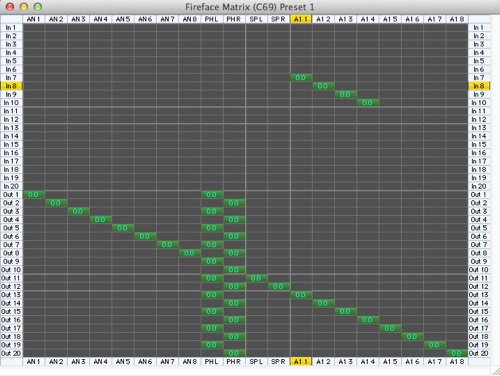
- Please DO NOT change these settings unless you know what you’re doing and return them once finished.
Phantom power
- Carefully connect Fireface 800 directly to your computer using the firewire cable on the rack system labeled 'Fireface 800'. Then use the Fireface Settings to turn phantom power on for microphones that require it.
- Confirm also that channels 7 and 8 are set to read from the Front of the Fireface 800 (the inputs can alternately read in from the rear of the device).
- Also confirm the Sample Rate is correct and clock mode is Slave and clock source is Word Clock/BNC. Once phantom power is turned on, Fireface can be disconnected from the computer.
- Note: Please turn off phantom power when you're done.
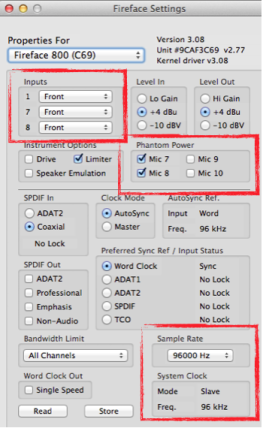
Troubleshooting
- Sound is coming out of the wrong channels.
- No sound!
- The sound image of my ambisonic material sounds odd, skewed or otherwise not correct.
- There are intermittent crackles/distortion in my sound.
- Sound is quiet with the Volume knob cranked up.
( Detailed Routing and Boot Instructions [opens another wiki page] )
Problem: Sound is coming out of the wrong channels.
- Check your Stereo setting. Remember this offsets your audio routing/decoding by 2 channels because the first 2 channels you send are assumed to be a stereo signal.
- Check your Decoder settings, especially if you're using a discrete routing– in some rooms there are multiple discrete routing options which send to specific, non-contiguous channels.
- Check that the sample rate matches between all the devices: the Web interface, Audio MIDI Setup, Fireface USB Settings applet, and the Big Ben in the gear rack (top unit). Sometimes the Fireface USB is running at half of the appropriate sample rate, creating a doubling of channels.
Problem: No sound!
- Confirm that the web interface and RME Settings sample rate matches the rack gear (topmost rack unit, with no flashing lights elsewhere in the rack).
- Double check the Gain fader, Mute, and Attenuation button settings in the web interface.
- Check the physical volume knob and mute switch on the desk.
- Still having trouble? If there is a room correction kernel running, you may need to switch the room correction setting to “basic_balance”, then back to your desired correction settings. Sometimes the correction process fails and needs to be reset.
Problem: The sound image of my ambisonic material sounds odd, skewed or otherwise not correct.
- RME TotalMix app may be sending audio to channels you don’t expect. In the Fireface USB Settings applet, make sure Options > Output > "Disable TotalMix”. While there, also confirm that the Output Format is set to a 96K Frame (which works for all sample rates).
- In the Web interface, double-check the Stereo setting is what you expect. Remember when Stereo is active, the first 2 channels you send the routing system are routed to the stereo speakers, and following channels are sent to the decoding/routing scheme you’ve selected. When Stereo is off, your output is sent straight to the decoder/router with no channel offset.
Problem: There are intermittent crackles/distortion in my sound.
- Check that your sample rates match across all devices and applications: the Web interface, Audio MIDI Setup, Fireface USB Settings applet, and the Big Ben in the gear rack (top unit). In Fireface USB Settings applet, check Clock Mode > Clock Source > "MADI Opt." (Note this is "BNC In" for Room 117). Here also confirm your Output Format is set to 96K Frame (which works for all sample rates).
- Check the Web interface to make sure you’re not boosting the signal digitally in the amplitude slider more than expected. This may clip your sound at the hardware output before the physical volume knob.
- Make sure you have the latest interface drivers for the Fireface USB. The driver version shows in the Fireface USB Settings applet. You can download the latest from the RME downloads site.
- If all of the above has been confirmed and the distortion persists, it may be a routing backend problem and may require a restart of the decoder machine. Contact one of the DXARTS staff to facilitate this.
Problem: Sound is quiet with the Volume knob cranked up.
- Confirm your source application is turned up to the right level. Check that you haven't unintentionally selected Attenuate (or Mute) on the web interface. If your source is quiet, you can turn up the router/decoder on the web interface by 12 dB. Remember to set it back to 0dB when you’re done.
Reservation Calendar
This calendar shows both Raitt 117 (blue) and 113 (yellow). Contact your instructor about making room reservations.
